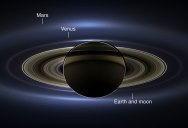Saturn, Venus, Mars and Earth All in One Photo

For a sense of scale, the image above sweeps nearly 405,000 miles (651,784 km) across Saturn and its inner rings. It’s the first image ever taken that shows Saturn, its moons and rings, Venus, Mars and Earth all at once. Unveiled on Tuesday, the natural-color, panoramic mosaic taken by NASA’s Cassini spacecraft shows the view as it would be seen by human eyes.

With both Cassini’s wide-angle and narrow-angle cameras aimed at Saturn, Cassini was able to capture 323 images in just over four hours. This final mosaic uses 141 of those wide-angle images. Images taken using the red, green and blue spectral filters of the wide-angle camera were combined and mosaicked together to create this natural-color view. [Source]

In the lower right of the mosaic, in between the bright blue E ring and the faint but defined G ring, is the pale blue dot of our planet, Earth. Look closely and you can see the moon protruding from the Earth’s lower right (click here for 9000×3500 px resolution). Earth’s twin, Venus, appears as a bright white dot in the upper left quadrant of the mosaic, also between the G and E rings. Mars also appears as a faint red dot embedded in the outer edge of the E ring, above and to the left of Venus. For ease of visibility, Earth, Venus, Mars, Enceladus, Epimetheus and Pandora were all brightened by a factor of eight and a half relative to Saturn. [Source]


A third annotated version of the image (click here for the 9000×3500 px version) labels Saturn’s numerous rings and moons such as: Enceladus, Prometheus, Tethys, Mimas, Pandora, Epimetheus, Janus, Janus’ ring and Pallene’s ring. [Source]


Cassini was approximately 746,000 miles (1.2 million kilometers) from Saturn when the images in this mosaic were taken. Launched in 1997, Cassini has explored the Saturn system for more than nine years. NASA plans to continue the mission through 2017, with the anticipation of many more images of Saturn, its rings and moons, as well as other scientific data. [Source]
If you enjoyed this post, the Sifter
highly recommends:

Sign up to get our BEST stories of the week straight to your inbox.




